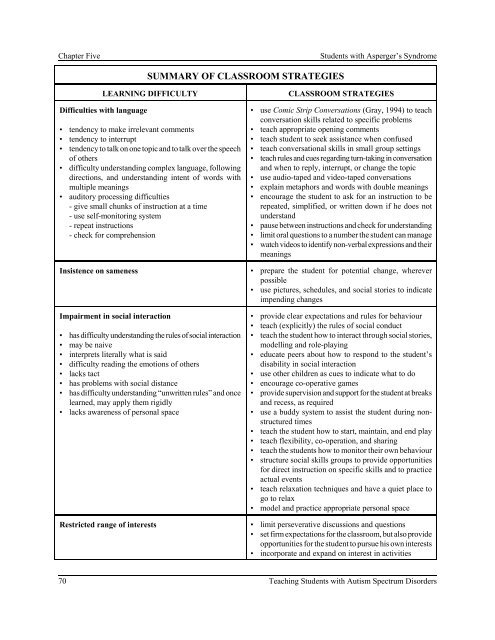Teaching Students with Autism Spectrum Disorders
Teaching Students with Autism Spectrum Disorders
Teaching Students with Autism Spectrum Disorders
Create successful ePaper yourself
Turn your PDF publications into a flip-book with our unique Google optimized e-Paper software.
Chapter Five <strong>Students</strong> <strong>with</strong> Asperger’s Syndrome<br />
SUMMARY OF CLASSROOM STRATEGIES<br />
LEARNING DIFFICULTY CLASSROOM STRATEGIES<br />
Difficulties <strong>with</strong> language<br />
• tendency to make irrelevant comments<br />
• tendency to interrupt<br />
• tendency to talk on one topic and to talk over the speech<br />
of others<br />
• difficulty understanding complex language, following<br />
directions, and understanding intent of words <strong>with</strong><br />
multiple meanings<br />
• auditory processing difficulties<br />
- give small chunks of instruction at a time<br />
- use self-monitoring system<br />
- repeat instructions<br />
- check for comprehension<br />
• use Comic Strip Conversations (Gray, 1994) to teach<br />
conversation skills related to specific problems<br />
• teach appropriate opening comments<br />
• teach student to seek assistance when confused<br />
• teach conversational skills in small group settings<br />
• teach rules and cues regarding turn-taking in conversation<br />
and when to reply, interrupt, or change the topic<br />
• use audio-taped and video-taped conversations<br />
• explain metaphors and words <strong>with</strong> double meanings<br />
• encourage the student to ask for an instruction to be<br />
repeated, simplified, or written down if he does not<br />
understand<br />
• pause between instructions and check for understanding<br />
• limit oral questions to a number the student can manage<br />
• watch videos to identify non-verbal expressions and their<br />
meanings<br />
Insistence on sameness • prepare the student for potential change, wherever<br />
possible<br />
• use pictures, schedules, and social stories to indicate<br />
impending changes<br />
Impairment in social interaction<br />
• has difficulty understanding the rules of social interaction<br />
• may be naive<br />
• interprets literally what is said<br />
• difficulty reading the emotions of others<br />
• lacks tact<br />
• has problems <strong>with</strong> social distance<br />
• has difficulty understanding “unwritten rules” and once<br />
learned, may apply them rigidly<br />
• lacks awareness of personal space<br />
• provide clear expectations and rules for behaviour<br />
• teach (explicitly) the rules of social conduct<br />
• teach the student how to interact through social stories,<br />
modelling and role-playing<br />
• educate peers about how to respond to the student’s<br />
disability in social interaction<br />
• use other children as cues to indicate what to do<br />
• encourage co-operative games<br />
• provide supervision and support for the student at breaks<br />
and recess, as required<br />
• use a buddy system to assist the student during nonstructured<br />
times<br />
• teach the student how to start, maintain, and end play<br />
• teach flexibility, co-operation, and sharing<br />
• teach the students how to monitor their own behaviour<br />
• structure social skills groups to provide opportunities<br />
for direct instruction on specific skills and to practice<br />
actual events<br />
• teach relaxation techniques and have a quiet place to<br />
go to relax<br />
• model and practice appropriate personal space<br />
Restricted range of interests • limit perseverative discussions and questions<br />
• set firm expectations for the classroom, but also provide<br />
opportunities for the student to pursue his own interests<br />
• incorporate and expand on interest in activities<br />
70 <strong>Teaching</strong> <strong>Students</strong> <strong>with</strong> <strong>Autism</strong> <strong>Spectrum</strong> <strong>Disorders</strong>

















